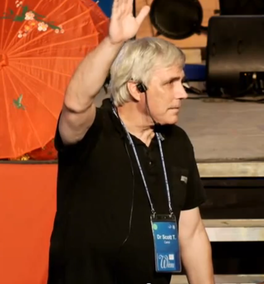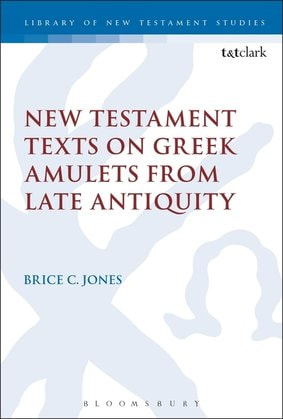 Scott Carroll Scott Carroll Over on her excellent blog, Roberta Mazza reflects on a very interesting video featuring Scott Carroll, former director of the Green Scholars Initiative (GSI), which I posted about last week. Carroll has apparently become known as the "Indiana Jones of biblical archaeology" (see here). I encourage all my readers to read Mazza's post and watch this video of Carroll (reproduced below), where he alludes to discoveries of all sorts of biblical and non-biblical texts, including the famous "1st century" fragment of Mark that has piqued everyone's curiosity (see previous post here). Be sure to watch this video if you can, because it provides a great deal of information about Carroll, the texts he and others have identified, his process of dismounting mummy masks (with photos!), his acquisitions of antiquities, etc. In the video, Carroll refers to a very large number of biblical and classical texts, and I find it amusing that almost all of these are, according to Carroll, the earliest texts of their kind in the world. I am curious about his dating methods, and why he is so confident in dating papyri to within a <40 year period (see comment below). In any case, the video raises more questions about Carroll and the Green Collection, for which he apparently amassed an enormous amount of items. For those who cannot watch the entire video (it is long), I have provided a list of interesting comments from Carroll below. "Often times the texts that are found are just common, everyday texts. But 5% are important." So, are the 95% "common, everyday texts" unimportant? "We found last year, I found, the earliest know text of Romans, the earliest known text of 1 Samuel, lost works of Sappho, tons of Homer." I wonder if the "lost works of Sappho" refer to the fragments recently published by Dirk Obbink, which Roberta Mazza has posted about here? "Look, what I'll briefly go down the list, what you need to understand is that the Times, the London Times Literary Supplement, that 30 of these items will be front page news when they're published." Ok. "We have the earliest text of Exodus 24 here. There's nothing earlier in the world. This is the earliest in the world. And you might not believe it or you wonder how do I know. Please understand that in the world I work in, people demand that you know. No one will pay $1.1 million for that text is in his hands [pointing to a glassed papyrus that is circulating among the audience] unless you know for sure that it dates when it dates to." First, it's disturbing that this papyrus would be passed around to a public audience. I am an advocate of "hands-on" learning when it comes to manuscripts, but I think it needs to be done in a controlled environment. Second, it would seem that someone or some group paid $1.1 million for this little fragment: I wonder how they feel about this papyrus being passed around like a hot potato? That's all that needs to be said here; my questions in this regard are probably also your questions. "If you look on the screen you see texts discovered of almost many of the Old Testament books with New Testament books, most of the Gospels, including a first century text of the Gospel of Mark. That's the earliest, that will be the earliest text of the New Testament [...] We're looking now at a text of Mark that dates between 70 and 110." See Brent Nongbri's judicious comments on dating small fragments like P52 in his article "The Use and Abuse of P52: Papyrological Pitfalls in the Dating of the Fourth Gospel," HTR 98.1 (2005): 23-48. This kind of certainty in dating small literary fragments ("between 70 and 110") is discouraged and avoided by most papyrologists. The recent article by P. Orsini and W. Clarysse comes to mind here for more than one reason: "Early New Testament Manuscripts and Their Dates: A Critique of Theological Palaeography," ETL 88.4 (2012): 443-474. "I was with my wife eating Thai in Okalhoma city, and I got a text from a collector in the Middle East. It was a box of broken papyrus. While we ate our good food, I noticed that the text was all written by the same hand. Looked like some of the pieces may fit together. Thought it looked like 1 Corinthians. Turned out to be 20 pages of 1 Corinthians." I would love to know more about this "collector in the Middle East." The statement suggests that Carroll and the collector were working close together. So, where are all these items coming from? "No pictures of the papyrus, please. They're not published. Just understand the value of these things are enormous. There are professors who from North America would send students here, they would pay their tickets and send them here, to do two things: to take pictures of the texts for them to publish and number two, to discredit you and us because they're [i.e., the papyri] in your hands." I don't know what "discredit" means in this context, but if he means that he would receive criticism from scholars for unpublished papyri being passed around in this manner, well then, yes, of course! In the comments section of a 2011 blog post about a papyrus of Hebrews someone on the "inside" of the Green collection reprimanded a Baylor doctoral student for taking pictures of this papyrus and blamed him for violating "Baylor's contractual agreement with the Exhibition." (In fact, the doctoral student in question did absolutely nothing wrong and broke no "contractual agreements." He disseminated information about the papyrus in a very appropriate manner, and many scholars reacted against the false charges and claims made against the doctoral student.) The anonymous comment went on to say that the doctoral student "took pictures, tried to work on the papyrus..." (a charge that is inaccurate). So, Carroll seems to be worried that his texts will be taken from him in a similar sense. "I want you to understand that the largest collection of scrolls in private hands 10 years ago was about 100, and I had the privilege of organizing that. Now the largest collection—I also had the privilege of organizing—is 4,500 scrolls. So we've been blessed to work with scrolls." I am guessing that the first collection ("10 years ago") refers to the private collection of Robert Van Kampen of Orlando, which Carroll also built (see here). "God used our frail inabilities and worked with us. This isn't the Quran! See, this is the Bible, God working graciously through fallen people to protect his word. So you don't need to create or continue far-fetched stories that don't match the evidence." No comment.
1 Comment
Jero Jones
link
9/5/2015 11:43:32 am
This Scott Carroll looks and sounds like a fake, or his diplomas are from crocker Jack box.
Reply
Your comment will be posted after it is approved.
Leave a Reply. |

Available at Amazon!
Archives
June 2020
Categories
All
|